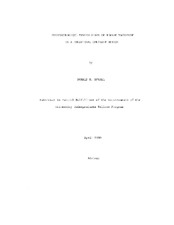| dc.description.abstract | Intracranial electrical stimulation of the brain can serve as a reward when administered to certain areas in and around the hypothalamus. These stimulation sites seem to be associated with major catecholamine (CA) pathways. On the basis of this information, and considering the fact that behavior induced by rewarding brain stimulation (RBS) resembles that produced by food, water or sex, it has been postulated that natural rewards may be mediated by one or more catecholamine neurotransmitters as well.
In an attempt to demonstrate that RBS and natural rewards share a common neurochemical basis, we observed the effects of a CA agonist, apomorphine, and a CA antagonist, haloperidol, on runway performance in a behavioral contrast design. Behavioral contrast effects occur when an animal, working for a certain reward magnitude, is suddenly shifted to a new reward magnitude. If the new magnitude of reward is higher than before, (+) contrast occurs; the animal shows disproportionately high rates of responding. If the new reward magnitude is lower than before, (-) contrast occurs and the animal shows disproportionately low rates of responding.
If natural reward is mediated by CA fibers, then contrast effects should occur following the injection of CA agonists or antagonists, even though the magnitude of the reward thay are receiving has not been changed. Changes in central CA activity would have altered the animals' subjective perception of the reward, and they would behave accordingly.
Contrast effects are commonly evaluated with various behavioral tests, such as the straight alley maze used here, which involve complex voluntary motor skills. Behavioral test results can be confounded by performance variables, such as drug induced changes in the CA activity of the substantia nigra, which influence the animal's motor functions. Therefore, before runway performance was observed for contrast effects under the influence of dopaminergic drugs, control subjects were given two tests designed to identify possible performance deficits, an open field test, and swimming tests of success and vigor. Neither haloperidol, nor apomorphine injected rats differed significantly from saline controls on either measure.
In the straight alley maze, haloperidol, a dopamine antagonist, produced significant reductions in run speeds (- contrast) using a saccharin reward. Apomorphine, a dopamine agonist, increased run speeds (+ contrast). It was concluded, therefore, that subjective reward magnitudes of a natural reward can be manipulated by the same drugs which influence the behavioral effects of RBS, without inducing performance deficits. This supports the hypothesis that both RBS and natural rewards are madiated by the same dopaminergic reward system.
These resultshave applications in the control of obesity, over-smoking, and endogenous depression. Further research using a behavioral contrast design in connection with other natural rewards is needed to discount the possible influence of confounding secondary variables such as "taste". | en |


